From Castel Madama to Lake Nemi, incorporating The Rome Mission and Diana’s sacred Grove
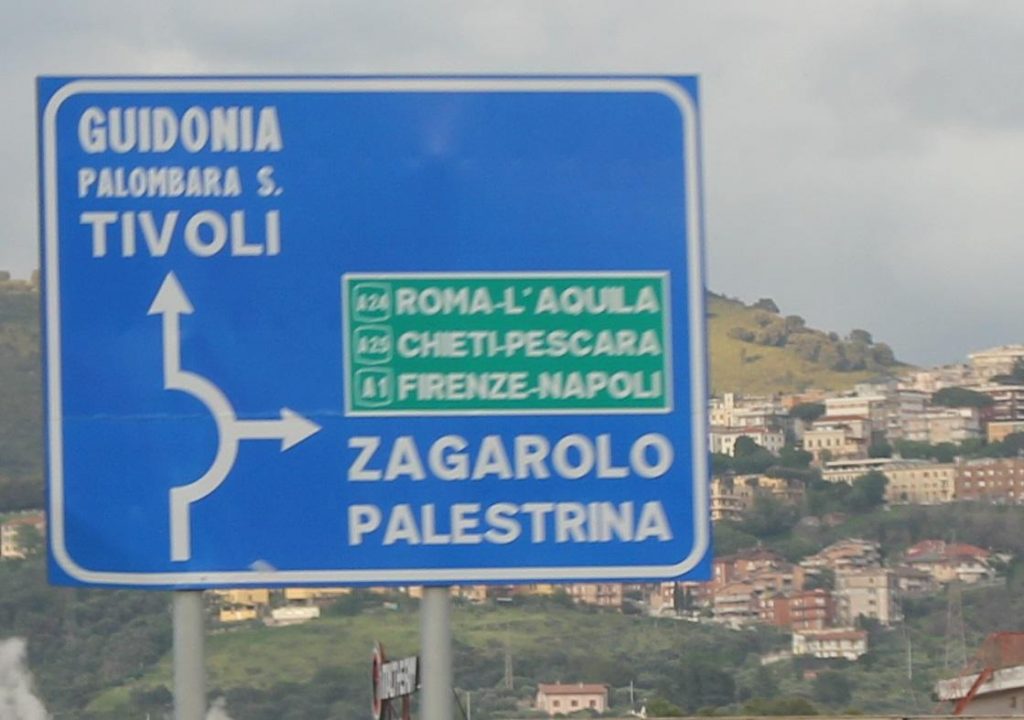
It should never have happened.
Regardless of those grand, white curving arrows on blue backgrounds brandishing ROMA, (bigger and brasher by far, than the workmanlike example pictured above), we were not going to Rome by road. Even experienced Italians had recalled their vow of: “Never again!”
No matter that every one of these dramatic signs teemed memorable filmic atmospheres to mind: from Rome, Open City (1945)[i]; Bicycle Thieves (1948)[ii] La Dolce Vita (1960)[iii] and Accattone (1961)[iv], to the mainstream comedy affair of Roman Holiday (1953) or Mario Bava’s more obscure The Girl Who Knew Too Much (1963)[v] . . . the roads themselves had to be resisted. We were going by train. None of those atmospheres could exist anymore and – flashing forward – few of them did. Yet, on reflection, something very distinctive remains, or came to the fore as the day wore on. It’s true that Roger Moore as The Saint (1962-69)[vi] in his white Volvo, would no longer be able to zoom entirely around the colosseum as if it were a glorified roundabout. Nor can anyone drive down the Via dei Fori Imperiali (Way of the Imperial Forums) any longer, since the entire, grand promenade has recently been pedestrianised – which can only be a good thing. But in spite of the excess tourists herding through the ruins of the goods yard to or from the locomotive roundhouse – queuing and jostling, trailing tour guides through the tired piazzas, overwhelming the fountains and steps – as London does to a Londoner, so the Eternal City remains magnetised, heavily real. If you can stay in a good mood, it has a weight – a heightened presence which readily incorporates both the historical and the mythological. Unless of course the everlasting impression of our experience, was an afternoon’s gift, granted by perfect weather and light?
From early in the morning and still tracking us, torrential rain had scuppered our visit to Tivoli and its famous gardens. The forecast for Rome, had looked better . . . if only we could have known earlier. Now, we’d left it too late to take the train.
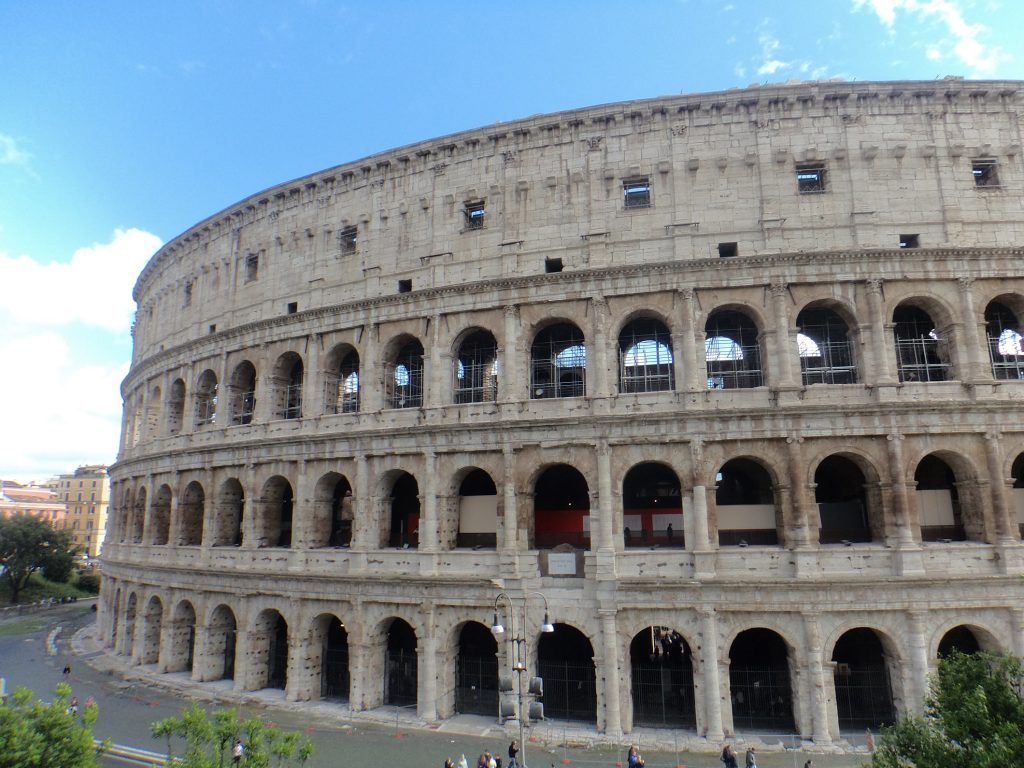
Old locomotive roundhouse, tracks and locos all gone. How I longed to see Simon Templar circulating this famous old building in The Saint’s white Volvo. 19th May 2019
Ten days it had taken to reach this part of Italy from the north of England. At first the Eurostar was too claustrophobic for my liking, but with tickets obtained at bargain price, I tried to believe I was somewhere else – and it did seem to reach Paris before I could blink. Similar to the Virgin Pendolino preceding it, this was not a real train, just a moving tube. As with cars, most real trains, at least in Europe, are dead. A fast walk across Paris brought us to a train less modernised – the Thello turned up the volume and headed south at a proper, clattering gallop. After a brief Venetian interlude, we took shelter in showery Treviso and later at Marcelli, as the Adriatic storm cleared. Branching inland at Pescara, we had eventually reached the 100% reality of Castel Madama, with its night shops, eventide weddings and midnight bells; with its bats and nocturnal crashing of recycling lorries; its milky way of stars and endless tooting competitions. Best of all, Castel Madama appeared to harbour no tourists at all – or in fact, anyone who knew a word of English. Despite this, as we found all over Italy, particularly away from the more famous cities, almost everyone was engaged, enthusiastic and helpful. Few of them were perpetually wrapped up in the latest technology. They did not stare downward as they sat or moved along. To such pursuits, they appeared to give a low priority. Italians generally (cue sweeping generalisation) appear genuinely less enamoured by mobiles and gadgets than Europeans further north. In Castel Madama, I barely spotted a screen in use.
But Castel Madama was now the comforting haven behind us, back behind a series of deluges and waterfalling roads with devious whirlpools disguising potholes as big as a Fiat 500. Now, aiming for Rome in this tiny, perilous, sometimes-floating blind-spot, I wondered if any semblance of sanity to which I might have aspired, had stayed behind, upstairs on the fourth floor at Via Libera[vii], dancing with Tommy Trinder under a fruit-laden hat, celebrating (hysterically) its foresight in staying at home.
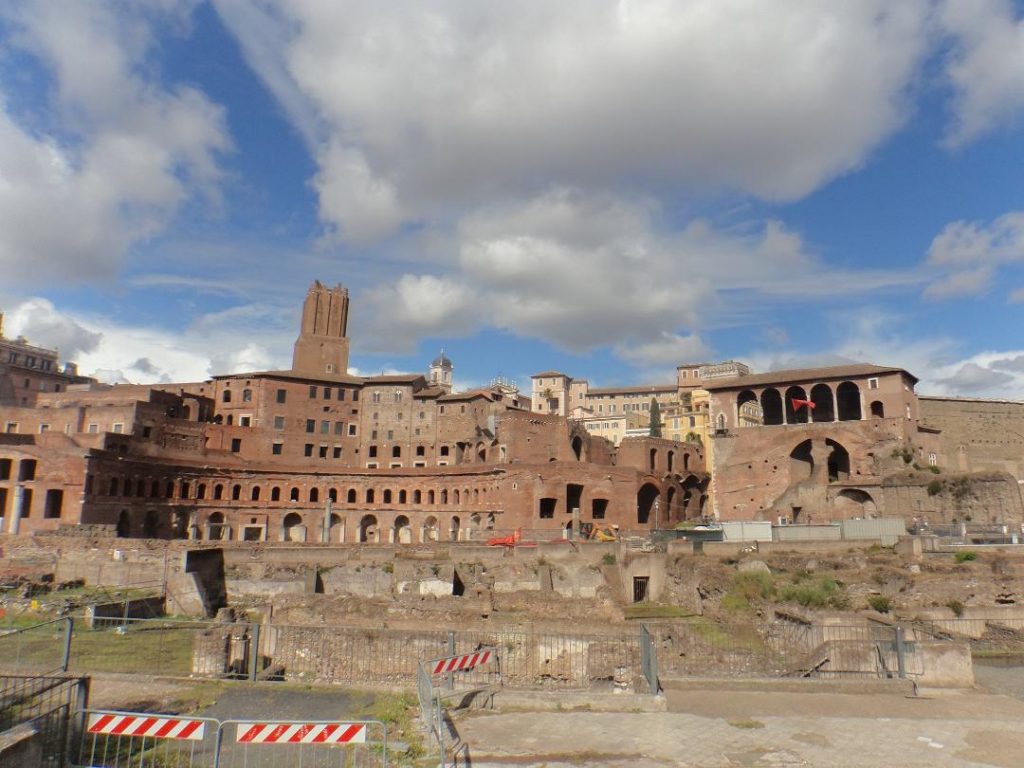
Remains of Romulus Central Interchange Parkway – free parking for chariots. 19th May 2019
Worse by far than the rain and general swash, were the piratical maniacs that recklessly piloted every fast-flashing, blaring thing on wheels abroad. The spirit of Dick Dastardly and his pigeon-hunt-crazed flying squadron[viii], lived in every Hurricane, Messerschmitt or TIE fighter around us, along with the strict principle – maintained for a hundred yards at least – of the wingman[ix].
Hurtling from every bend and jagging every straight, the leading car would be on the centre line, the wingman well over it, hooked on by bumper lock. Not just the oncoming was a threat; in our direction also, we were railroaded and rammed from behind, hassled by flashing lights and instant impatience. “Look at the speed limits” . . . I dared to shout to K, rashly, if momentarily, releasing the double-clamp finger-vice of my hands on the wheel, to make an impetuous, foolhardy gesture of sub-Italian flamboyance: “Look at the speed limits!” I exclaimed as another flashed by, “and DOUBLE THEM.” Even though I tried to resist the flow, an electronic scoreboard by a 40 limit, registered 80 for me as I was narrowly overtaken yet again. Our small black snail was an obstacle to triumph over before the next narrow escape. Lorries, absorbed in mist-spray, ghosts of death, almost invisible, were their greatest challenge. Could the dicers with long odds, accelerate to make the inward swerve in time? The looming lorries never slowed, flashed nor blared. They just thundered on regardless. This was normality. If there’d been time or I’d had any humour left, I would have remembered one of the greatest of not just Italian films, but of all films, Il Sorpasso[x] (1962), whose title derives from an overtaking manoeuvre[xi]. Dino Risi’s best film by reckless miles, stars a louder-and-brasher-than-the-biggest Italian road-sign, Vittorio Gassman, a pensive Jean-Louis Trintignant and the ever-divinely radiant Catherine Spaak – not to mention a Lancia Aurelia B24. To describe it as a comedy is underselling it by a swerving petrol-tanker.
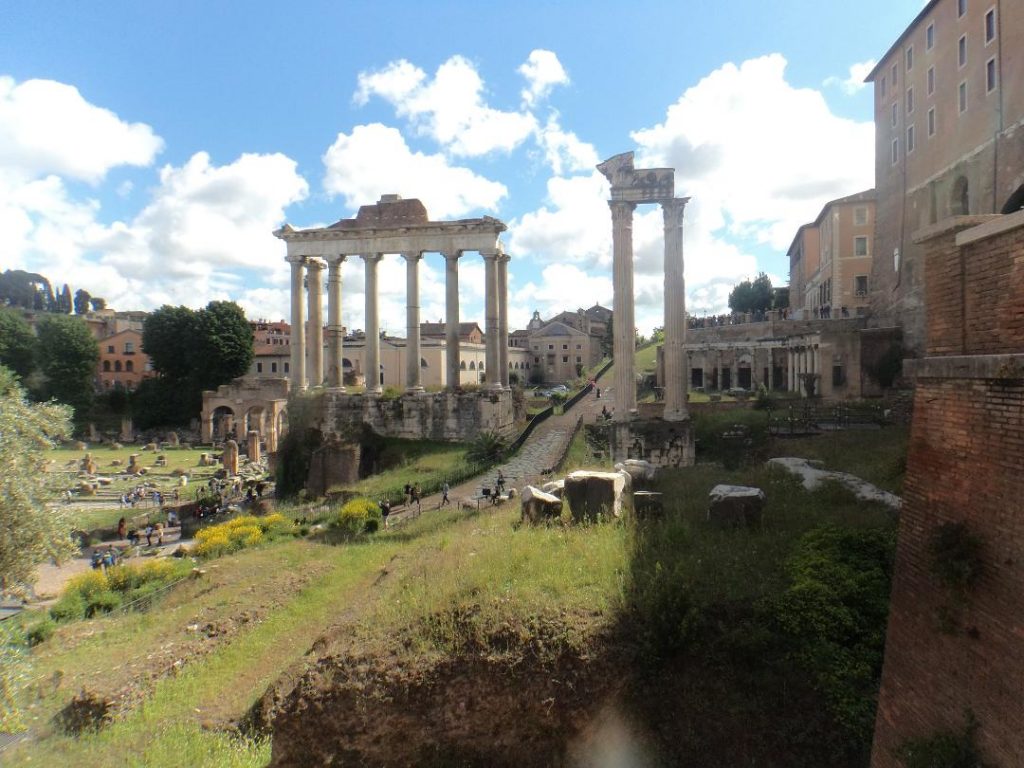
What’s left of the goods yard – the dispatch office 19th May 2019
No wing men, oncoming or behind, stuck around for long. They didn’t wait for promotion. Constantly in the mirror or from the stair-rods of rain ahead, with glaring lights, abruptly they’d blast past, resisting a trigger-burst of gunfire. No matter how fast we were pushed on, always there was another Kamikaze eager to take up the contest. Is ordinary life so dull? Does every day have to be a homage to Star Wars or the Battle of Britain? Just how astronomical is the mortality rate anyway? Therefore, Roma was a place we were going by train. Except we weren’t, and by now we were rotating and falling into the centre, caught in a racing whirlpool of traffic, multiple lanes, arbitrary traffic lights of which few took much notice. “Go! Go! Go Now!” K shouted at junctions. Apartments, ruins, helter-skelter roundabouts, taxis pushing, scooters scooting, drivers jeering . . . Glimpsing the terminal station in the left distance, rapidly we were swirling round the Piazza della Repubblica. Breaking from the maelstrom, the current slowed. We headed up a quieter street to see, miracle of miracles: a parking space! Quickly we took refuge and then stopped to think. K and the children got out to stand on the path and breathe many sighs of relief. Praise be! So far, we had survived!
Yet regardless of all the parked cars, everywhere around us, lurked forests of tow-away symbols. There were tow-away symbols on poles and walls. Tow-away symbols stuck to windows. Tow-away symbols forlorn on buckled fences that cars had parked on. At least where we were, our vehicle looked mildly legitimate . . .
Another car drew up. Hoping we were about to leave? I got out to speak to them, forgetting I would neither understand nor be understood. Five people in their mid-to-late twenties were crammed into the car, all of them grinning. All knew some English. Could I park here? I asked. They had no idea. Glancing at the space, I could see there was just about room for them, if I shifted forwards. They were enthusiastic, so I ran around and jumped in the car. No steering wheel! I’d jumped in the passenger seat. Drat and double-drat, it’s a left-hand drive. Getting out, I hurried back and climbed in the side I’d recently got out of, while everyone in the car alongside laughed indulgently. Soon they were all free and we gathered on the pavement to smile and bask in a burst of sun. It shone therapeutically down, reflected off the multitudes of tow-away symbols, glinting from the weirdly cambered windscreens of lop-sided, chucked all over the place, casually abandoned cars. Fanning out, we set off to try and discover the local parking regulations. The man I was with, after much reading, remained unsure. Signs were vague, but he reckoned on a Sunday it would probably be alright. He shrugged his shoulders. Probably alright. Trusting to luck, we collected what we needed from the cars and shaking hands, went our separate ways.
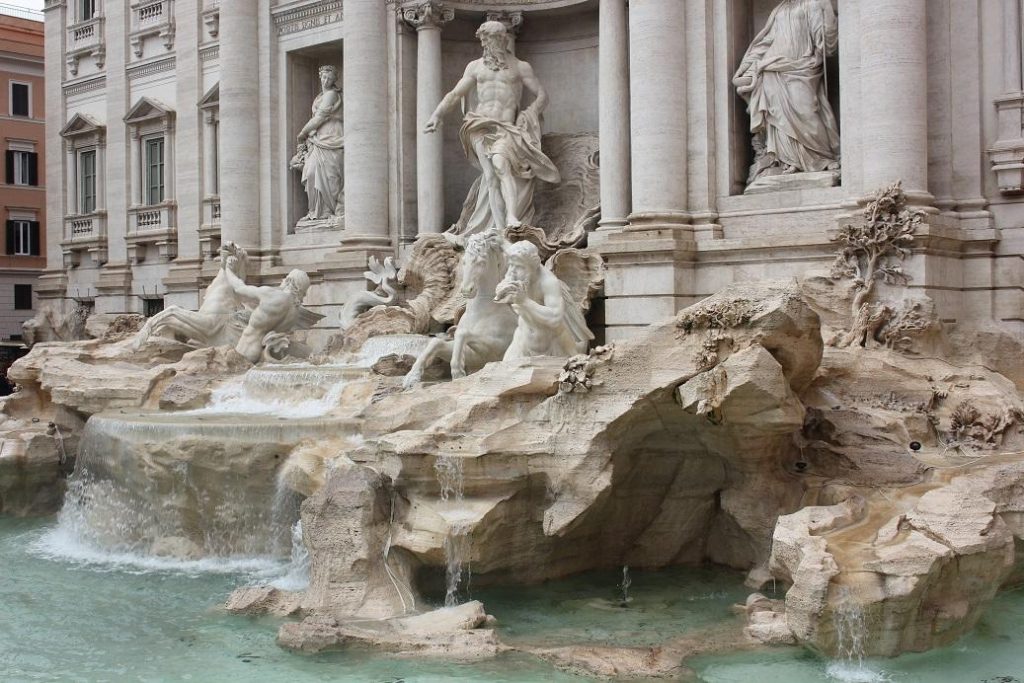
The Trevi fountain with all the tourists and umbrella salesmen trimmed off by a tight focus
At first, the odd heavy shower forced us to shelter in doorways and ignore the umbrella and waterproof sellers. After passing the Trevi fountain – where spectators were ten or fifteen deep – and the sea of sloping heads that concealed the Spanish Steps, we reached the gardens of the Villa Borghese. Here amongst the trees, horse-drawn or pedal-powered conveyances strayed back and forth. Abruptly, the light became lastingly incredible. For the rest of the day, it was as though we were on a peninsula such as at St. Ives in Cornwall or the isthmus of Sirmio, so loved by Catullus[xii] which projects into Lake Garda[xiii]. In such places, in the right weather, everything seems to have more presence than usual. The optical explanation would be refraction from all the surrounding water, and a similar thing may happen in atmospheres of a certain humidity. But such explanations miss much of the effect. They are akin to describing Il Sorpasso, as merely a comedy.
Rome, at least as I’d previously encountered it in films, books and photographs, is usually shown as dusty or at best brass-laden, glaring, dehydrated. The light we had all that sunny afternoon, on our epic walking tour past both the usual highlighted places and others more obscure, was magical and entrancing. Even after the cool-after-rain air became fiercely hot, under the varied sailing skies, the light never went flat.
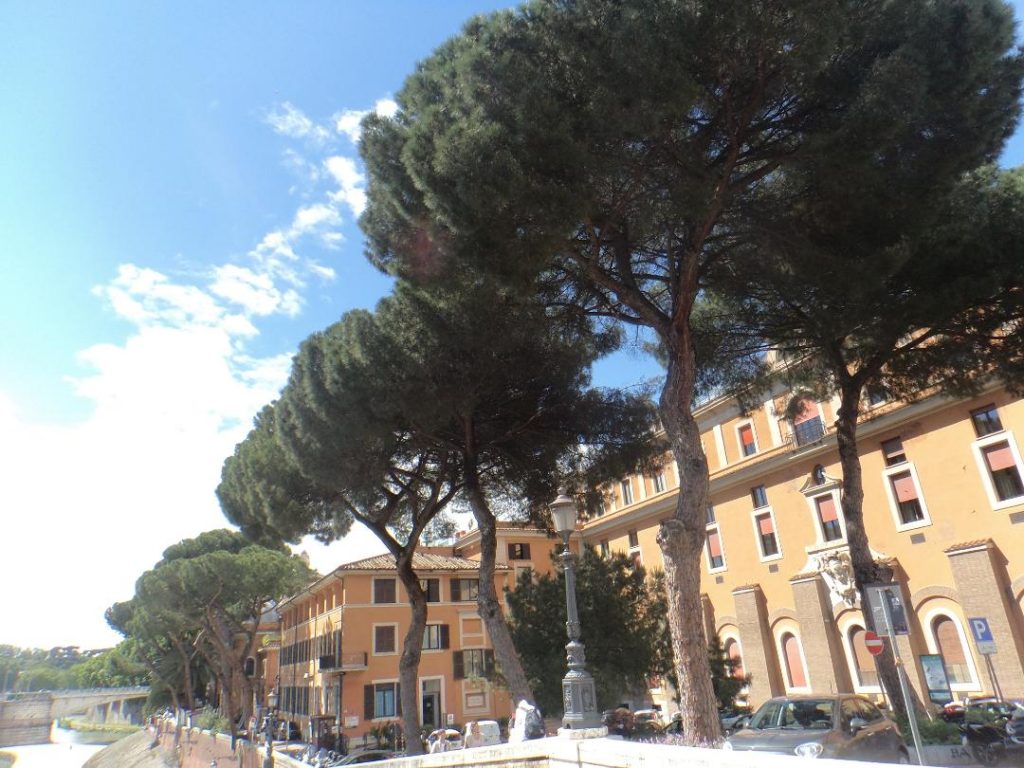
Isola Tiberina, Rome, 19th May 2019
Another recurring location for Roman films is the famous river Tiber as it loops through the city – in which it tends to look like a wide, shallow sewer. Belle ma Povere (1957)[xiv], certainly gives this impression. That day, not surprisingly given the widespread cloudbursts all over the region, it was high and fresh, the weir at Isola Tiberina aspiring to be an everlasting surfing barrel. But most impressive of all were the trees all over Rome. Originally introduced from Africa, and useful for their edible nuts[xv], these I discovered, were stone pines[xvi]. While some have a classical, symmetrical shape, others appear sturdily demented, with branches and foliage three-dimensionally embodying distorted Rorschach blots. Individually or in groups or canopies they rise above the city, silently sentient gods, temporarily imprisoned. At junior school, I remember an enthusiastic music teacher forcing us to listen to Respighi’s Pines of Rome[xvii] though I can’t recall what I felt. Like no doubt most city overspill kids exiled to new council estates, I would have been resistant to any overtly ‘beautiful’ music, especially ‘classical’. Being artistically minded, my parents did have a few classical records of which two had earned my respect: Dvořák’s New World Symphony was one of them, but I suspect it was mostly the cover of the L.P. that impressed me: an unforgettable nocturne of The Brooklyn Bridge. This, I’ve failed to trace, so I’m not even sure if it was photograph or painting. Either way, I stared at it for countless vinyl performances. The other record I liked was Tchaikovsky’s 1812 Overture – mostly for the cannon explosions at the end, anticipated all the way through and which I would have kept repeating if I’d been allowed to fiddle with the record arm. I often wondered how many concert halls were destroyed by those cannons or whether they made special holes in the walls for the cannonballs to go through. “Spect they only perform it outside,” somebody suggested, “or just use recorded cannons?” which spoilt the effect.
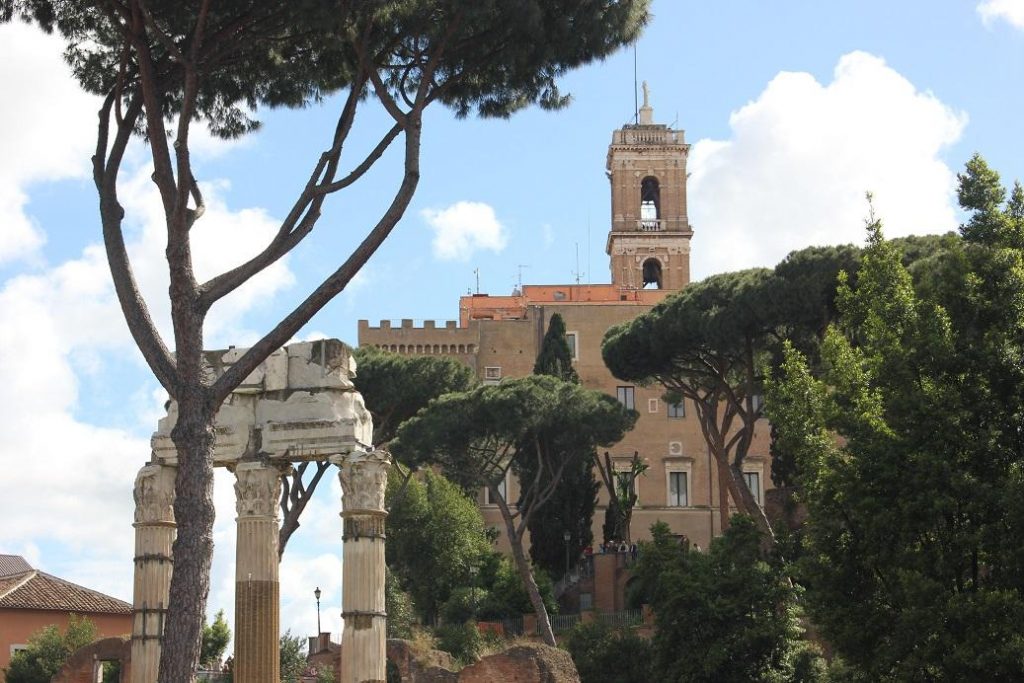
Crazy stone pines
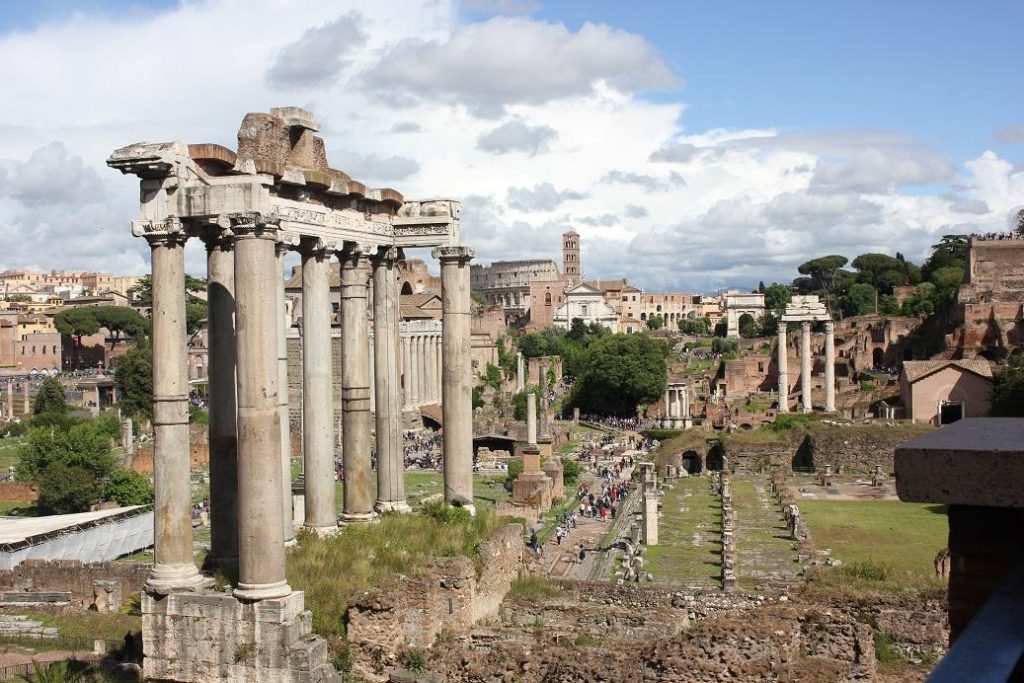
Ruined Parcel office
It simplifies sightseeing, that unless I’m in desperate need of shade, generally, I prefer not to go inside buildings, just about the only exception in Rome, being a small supermarket and the Chiesa di Santa Maria in Campitelli – with its altar of gilded glory, which like a baroque version times-ten, brought to mind those kitsch but massively appealing, 50s and 60s starburst clocks . Thinking of which, what increasingly I did miss seeing was The Saint’s white Volvo P1800, and all those legions of splendid coloured coaches also of 50s and 60s vintage, which since the advent of pedestrianisation, no longer fill St. Peter’s Square, the Piazza del Popolo or Piazza della Repubblica. Apart from the odd preserved example, the stylish cars and buses of those days, really are no more. In visual terms, modern vehicles are beneath contempt. You’d think one manufacturer could come up with a vehicle as good-looking as one from the past. Perhaps they are bound by too many rules of safety, efficiency and economy? Since combustion engines need to be gradually abolished, maybe this failure is a good thing. People might miss the convenience of the combustion vehicle, but it would be an effort to miss anything about their current appearance.
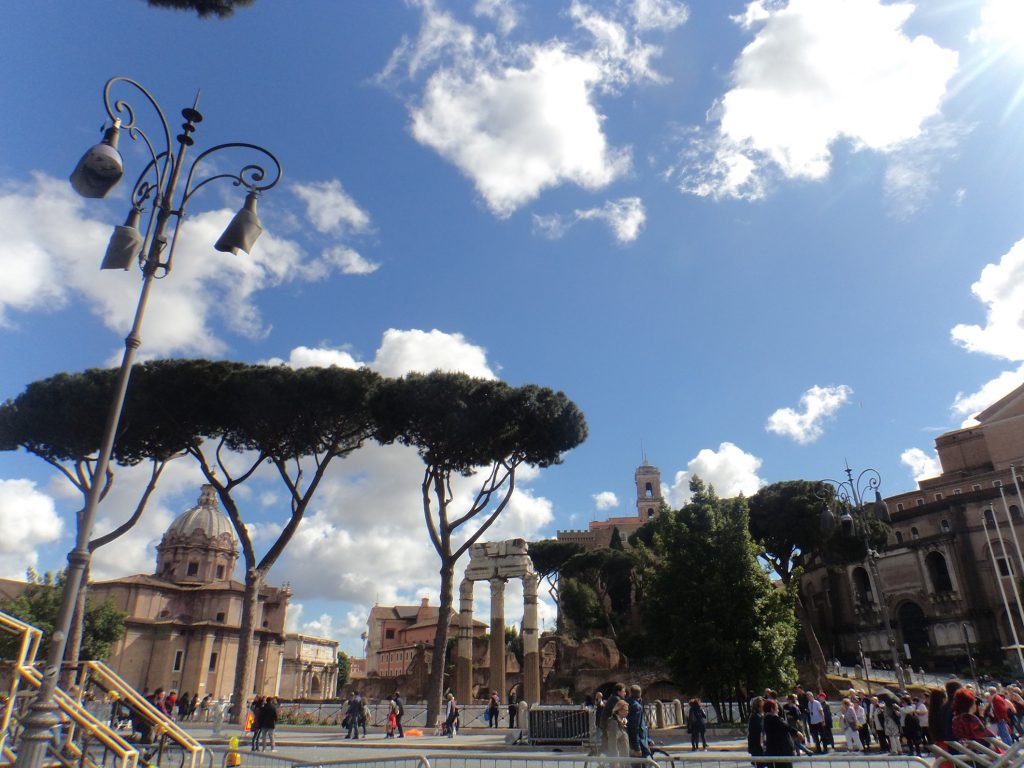
Yet more great Stone pines, Rome 19th May 2019
Rome proved even harder to leave than to enter – if not quite so dangerous. Mesmerised by yet more avenues of stone pines stretching in every direction, covered now it seemed with a haze dust of seeds in early evening, the return journey involved several dead-ends under ranks of apartments tailing into fields. Slipping too far north in Municipio III, when we should have been in Municipio IV, we almost ended up on the road to La Cinquina Bufalotta. Backtracking, including a short section the wrong way up a one-way bit of serious roadworks, we finally escaped to find Tivoli still under indigo skies.
Since returning to dear old Blighty, we have received advanced warning of one traffic fine. Supposedly, we infringed a bus lane. All we remember of this was a crash blocking the lanes to the left when everything was forced to use the bus lane – so I’ll want clear, photographic evidence before I consider coughing up.
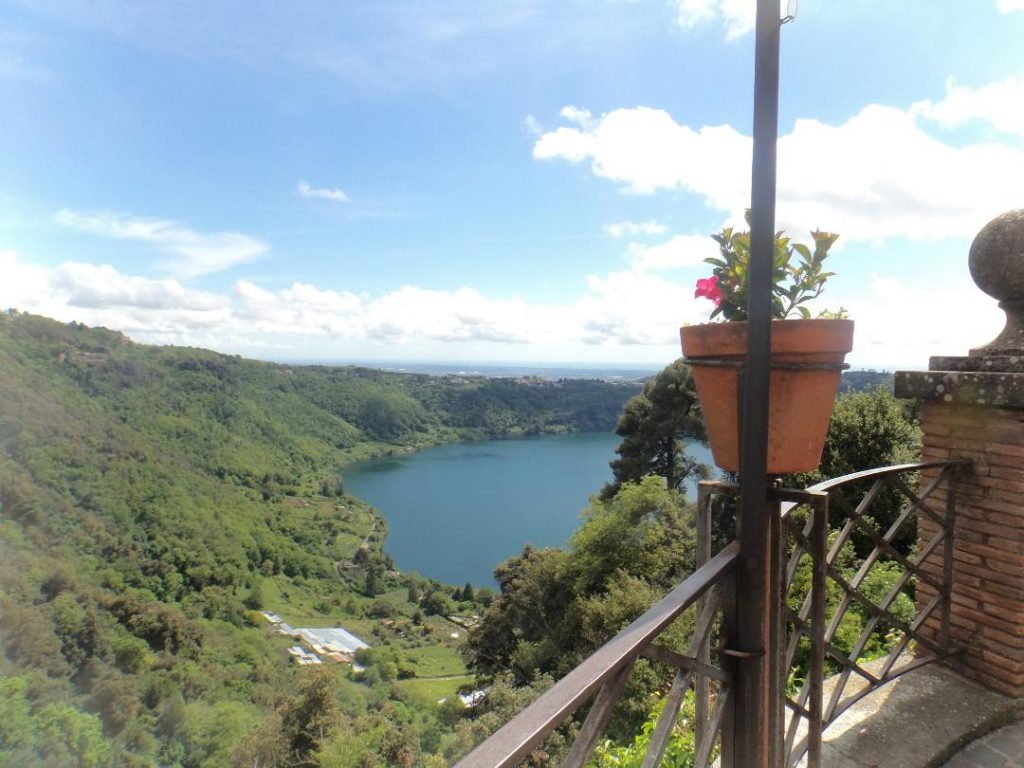
Crater lake at Nemi 20th May 2019
Heavy rain for much of the night, showed no sign of stopping the following morning, leaving Tivoli likely to be a washout. Casting about for somewhere nearby to explore, skimming the map, I came upon Nemi. Fragments of The Golden Bough, muddled and misremembered, made the map around Nemi – with its crater lake in a dormant or deceased volcano – come alive. I could almost see Baldr the beautiful[xix] being slain by a spear of mistletoe – as if this Norse tragedy took place 2000 miles south at Diana’s Sacred grove[xx] in the fertile woods around Nemi . . .
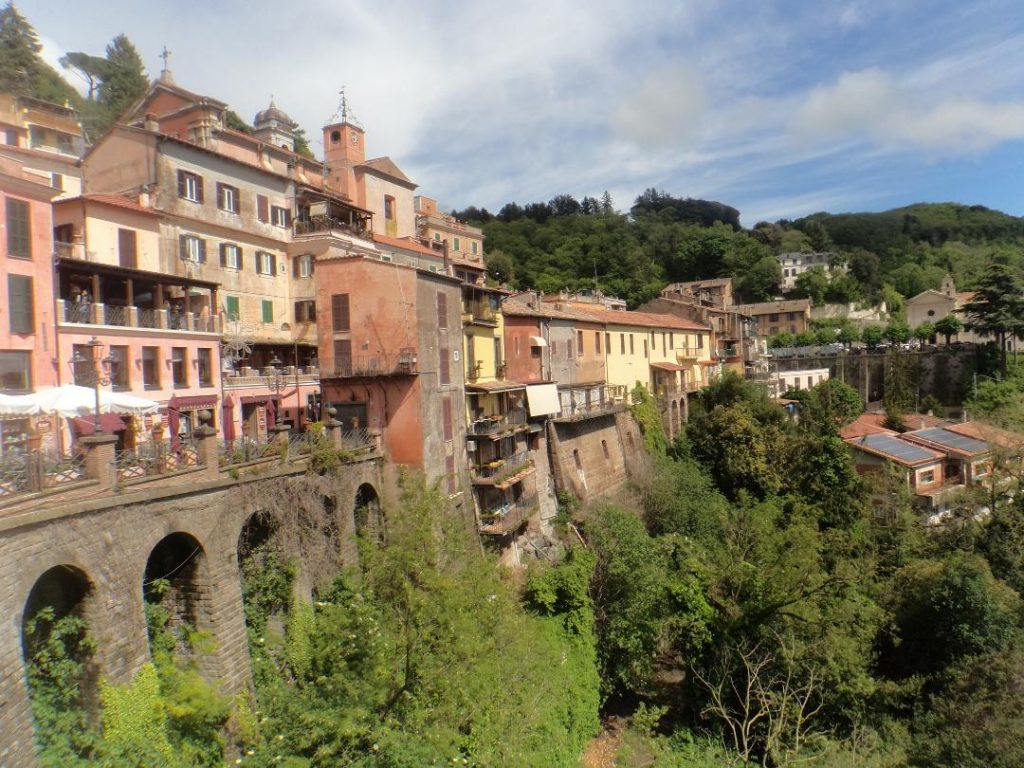
Nemi – on the side of the crater
For a place that must be formidably tourist-bound, we were very lucky at Nemi. The torrents of rain and burst drains that made the morning lanes and highways worse even than the day before, must have kept everyone indoors. After a false road terminated at a collapsed tunnel, the rains slowed. Finding another route, the dampened town was fresh, and we had it almost to ourselves. As the drizzle died away, just past the fountain of the Medusa (Fontane della Gorgone[xxi]) we passed through what looked like an old castle gateway to discover a bench overlooking the fertile fields and lake far below. A myriad of colourful allotments sheltered in the crater. This high vantage point was the perfect place to sit and have lunch. Halfway through, a policeman approached us, and I wondered if we were going to be told to move, or that I shouldn’t be drinking wine in a public place. But apologetically, he was only concerned we wouldn’t leave any litter behind – or worse still, throw it over the cliff, apparently a common occurrence.
Only after the sun had been out for a couple of hours and we were on our way back along the Via Giulia, did the town start to become busy. Shopkeepers offering local produce, including its famous wild strawberries, appeared in their doorways looking happier. One beckoned us in to sample his liqueurs. With these he was so generous that we decided to buy a bottle for our son’s birthday, even though it meant adding it to our permanent luggage. Almost all the liqueurs were strange in both colour and taste, but Lavender was most bizarre of all. It looked like purple-dyed meths into the bargain. How could we resist?
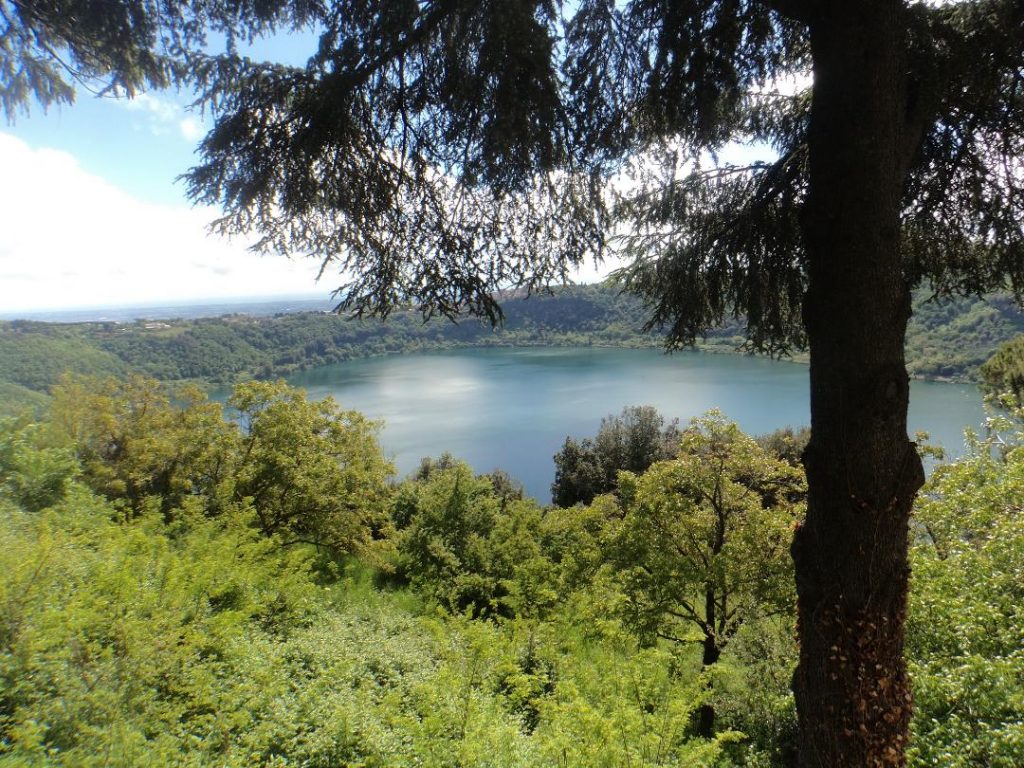
Crater lake and the distant Mediterranean from the sacred grove perhaps
The legends and stories about Nemi and its environs are legion – one of the most extraordinary being the speculation around Caligula’s luxury barges. I imagined these to be modest in size, more like glorified rafts. In fact, in photos of them – as finally raised by Mussolini, determined to match the follies of his equally insane predecessors and prove himself an emperor – they were vast and took the shape of wide laurel leaves. As a platform for orgies and general excess, the fuller story[xxii] of these unlikely craft, right up to their final incineration, deliberate or accidental, by the retreating Germans, the Allies, or sheltering refugees[xxiii], no-one seems clear who’s to blame, is hard to believe.
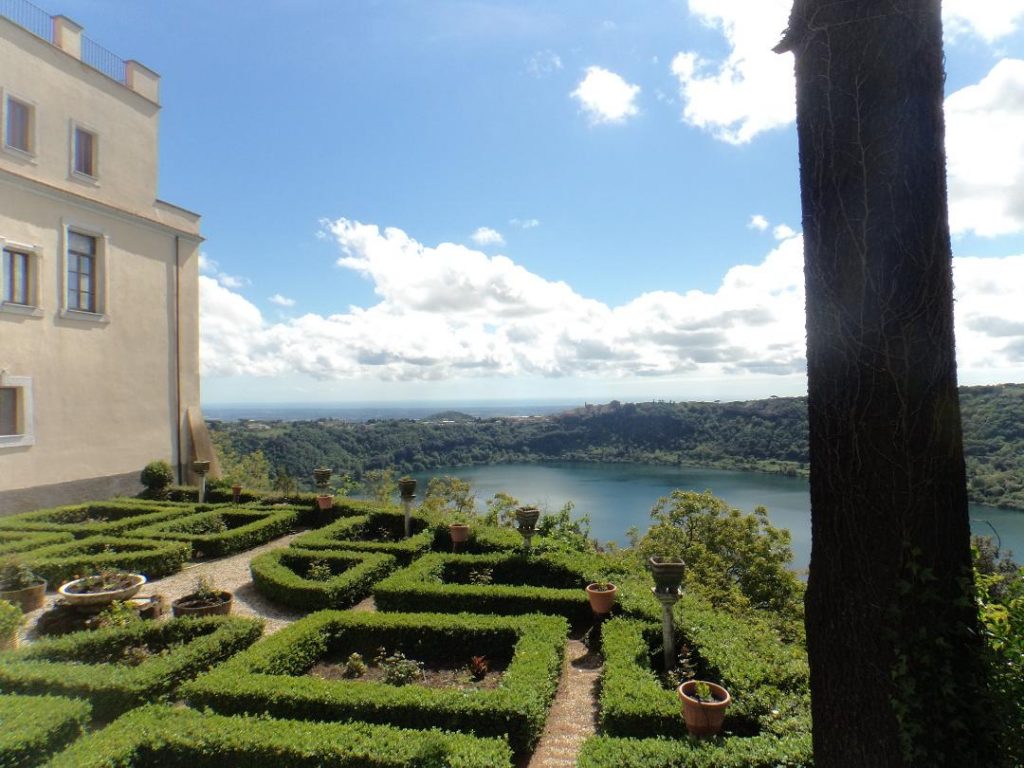
Diana’s Bed and Breakfast (previously known as the Angout of Artemis) 20th May 2019
We only encountered Muriel Spark’s curious novel set in Nemi, The Takeover[xxiv], after returning home and inevitably, more than forty years later, some of its socio-political targets have shape-shifted. More an intriguing character study, as a novel in the traditional sense, The Takeover never really gets going . . . and shortly fizzles out. It’s hard to know whether it might have seemed better or worse had we not known Nemi itself. Spark’s background locale fails to ignite: apart from a few, minor, specifically Italian details, the buildings and people could just as easily be imagined at Shaldon in Devon or Llandrindod Wells in Radnorshire (Powys) – the latter town even having a high lake. The new Diana cult, cynically stirred into life by one of The Takeover’s main characters, Hubert Mallindaine, could have helped underwrite a very distinctive setting, but this potentially rich strand develops listlessly and never catches fire. Although the satirical aspects of the self-indulgent rich and their thoughtless lives, of bogus cults and economic crises, could still apply today, somehow The Takeover, has the air of one of those ultimately pointless soap operas or T.V. drama series that never knows when it should have ended – and which rely on a fascination or addiction to the hackneyed melodramas and universal boredoms of life, any life, so long as it’s not our own. Perhaps I’m being over-harsh and some hidden light in The Takeover would reveal itself given a second chance, which is certainly true of many subtle films – and like Roland Barthes[xxv] I’m all for experiencing books and films a second time or more. But The Takeover feels written to pay the rent instead of from the heart.
As for long-form television and binge watching, I have no desire to become the latest willing sacrifice to such mind-suicide. Nowadays, even the great film writer David Thomson[xxvi] it appears may have succumbed! To be a writer, a reader, and be lost in alternative lives that persist until viewing figures fall away, would leave little time for life itself, or the outdoor world. I indulge in some enjoyable trash – 50s films especially – but they rarely exceed ninety minutes. The big advantage poetry has over novels is concision, and although I appreciate epic rambling novels, the best of these can be picked up and put down at will (forget the page-turner, in almost every case they’re operating with low, instinctive denominators, the literary equivalent of an inventive but endless car chase). Books require no power or signal and can be taken outside[xxvii]. The best books are always interested in what is beyond them, whereas all but (perhaps) the very best long-form T.V. cannot help but encourage a mental lassitude. They absorb rather than genuinely stimulate. Everything is done for you: every setting, every nuance, every expression. No wonder they are popular at the end of a working day or in replacement for the lack of it. The best films will always be more valuable: their superiority lies in their very compression. Two hours, more or less, does not waste so much of our valuable time. Better to watch such great films as Il Sorpasso, Wild Strawberries (1957), Orphée (1950) or Inherent Vice (2014) again and again, than get mired in an endless shaggy dog drama which keeps reviving like a vampire inadequately staked[xxviii].
Ultimately, in his zooming out, accurately dystopian, global perspective, Thomson, seems to be proposing (or is this just me?) that binge television-watching – an understandable withdrawal into autumnal comforts for him and his wife – is one of the symptoms of “the end is not just nigh, but now”. . . which is not a very cheerful note on which to end. Rather than “doing an insane thing” (D. T’s description of “the rapture” in T.V. series binge-watching), “so as to ignore more pervasive dysfunction”, it would surely be better to turn off all our screens, and try to do something about our predicament? Just like eternally optimistic Tommy Trinder (yes, him again) did in The Foreman Went to France (1942)!
Lawrence Freiesleben, Italy and Cumbria, May & Autumn 2019
[i] https://www.imdb.com/title/tt0038890/?ref_=nv_sr_1?ref_=nv_sr_1
[ii] https://www.imdb.com/title/tt0040522/?ref_=nv_sr_1?ref_=nv_sr_1
[iii] https://www.imdb.com/title/tt0053779/?ref_=nv_sr_1?ref_=nv_sr_1
[iv] https://www.imdb.com/title/tt0054599/?ref_=nv_sr_1?ref_=nv_sr_1 with the unforgettable Franco Citta – who reminds me of a kid I used to know at secondary school. Amongst other eccentric practices, in winter he used to wear plastic bags on his feet over his socks inside his boots to keep his feet warm.
[v] https://www.imdb.com/title/tt0057443/?ref_=nv_sr_1?ref_=nv_sr_1
[vi] https://www.imdb.com/title/tt0055701/?ref_=nm_flmg_act_56
[vii] See part 3 of this Digression: http://internationaltimes.it/the-italian-digression-part-3-from-lake-barrea-to-castel-madama/
[viii] https://www.imdb.com/title/tt0063889/?ref_=nv_sr_1?ref_=nv_sr_1
[ix] https://en.wikipedia.org/wiki/Wingman
[x] https://www.imdb.com/title/tt0056512/
[xi] https://en.wikipedia.org/wiki/Il_Sorpasso
[xii] Homecoming by Catullus: “Gem of all isthmuses and isles that lie / Fresh or salt water’s children, in clear lake” . . . or so runs the beginning of C.S. Calverley’s translation in ‘Voices From the Past’, Phoenix House Ltd 1955.
[xiii] From Poets in a Landscape by Gilbert Highet, Pelican Books A445 (1959, first published 1957) page 40: “And when the sun strikes the waters and scatters a million broken rays upon them, the whole surface seems to be dancing and laughing for mile upon mile. To stand far out on the peninsula, to see the vistas of blue and pale gold receding among the cloud-shadowed hills, and to hear the water clean and brisk, lapping almost all around, is a rare delight. Sirmio then seems like a stout little boat sailing forward through the welcoming waves.
[xiv] https://www.imdb.com/title/tt0050181/ a lesser Dino Risi film, but full of local colour and Marisa Allasio.
[xv] http://www.pinonnuts.com/pinon%20nut%20history.html
[xvi] https://en.wikipedia.org/wiki/Stone_pine
[xvii] http://www.romality.com/2019/03/25/pines-of-rome/
[xviii] https://www.pinterest.co.uk/telechrontime/mid-century-50s-and-60s-starburst-clocks/
[xix] https://en.wikipedia.org/wiki/Baldr
[xx] https://en.wikipedia.org/wiki/Diana_Nemorensis
[xxi] https://www.tripadvisor.co.uk/Attraction_Review-g794657-d12819489-Reviews-Fontana_della_Gorgone_Medusa-Nemi_Province_of_Rome_Lazio.html
[xxiii] https://en.wikipedia.org/wiki/Nemi
[xxiv] Reviewed by Margaret Drabble in the New York Times of October 3, 1976, under the title of “A
Glittering, Knowing Novel About the Decline of the West” – which makes it sound better than it is, but in 1976 the topical details would have been more obvious:
http://movies2.nytimes.com/books/97/05/11/reviews/spark-takeover.html
[xxv] To quote Maria Palacios Cruz (Sight & Sound, April 2019 page 17), According to Barthes, rereading is “an operation contrary to the commercial and ideological habits of our society, which would have us ‘throw away’ the story once it is consumed. Such repetition has a chance perhaps, of establishing a “more collaborative relation with the text”?
[xxvi] In the Belly of the Binge, a Sight & Sound article by David Thomson (April 2019, page 22) about “the culture of binge-watching big-budget series at home” and how the “compulsive, rapturous thrall such shows hold us in, is something to be celebrated, and the mark of a new age.”
Although I’m sure some of these shows are great, (and I’ve sat through and swiftly blurred a few myself, although never in binges), I suspect that all our addiction indicates is the increasing gradient of our decadent decline. I’d certainly enjoy – as would many – clearing decorative cake stands of gateaux and pastries all day long. If that became universal and widespread it might be the mark of a new age, but hardly one to celebrate.
[xxvii] Even in e-book device form, their requirements are limited – or so friends have told me.
[xxviii] From Escape from the Hyperion, (Sept 2019, as yet unpublished).

Even though this is a piece ostensibly about Italy, I love how reading it makes me feel like I am spanning so many aeons, skipping momentarily to other parts of the world, a kind of spatio-temportal ‘flow’. Absorbed in mind, kind of everywhere and nowhere.
Comment by Martin on 6 December, 2022 at 5:36 pm